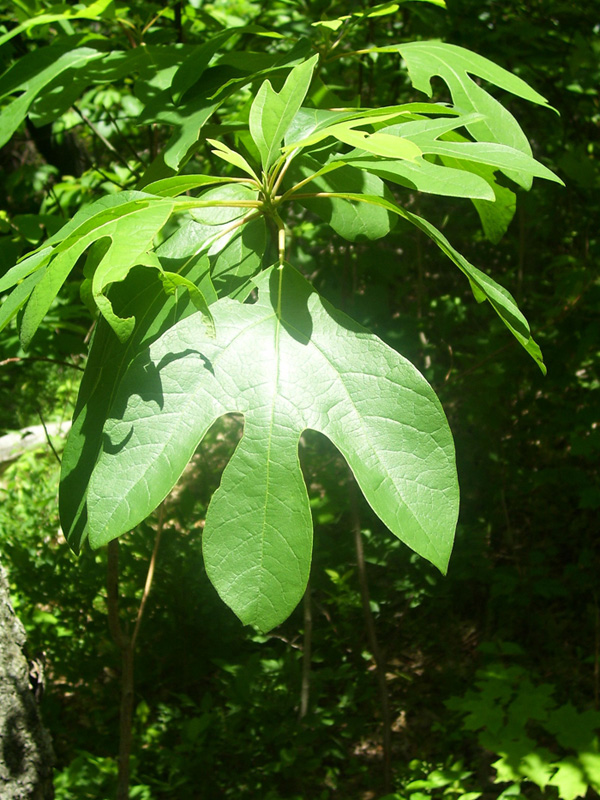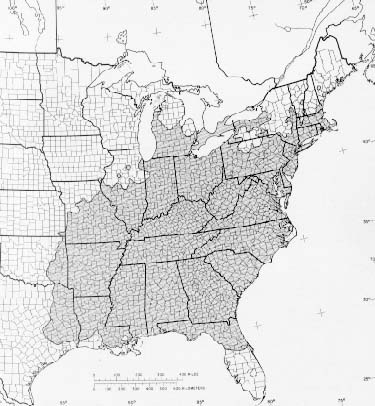- Sassafras albidum
image_caption = "Sassafras albidum",Wanaque, New Jersey
regnum =Plant ae
unranked_divisio =Angiosperm s
unranked_classis =Magnoliid s
ordo =Laurales
familia =Lauraceae
genus = "Sassafras "
species = "S. albidum"
binomial = "Sassafras albidum"
binomial_authority = (Nutt.) Nees
range_
range_map_caption = Range
range_map_caption = Range|"Sassafras albidum" (Sassafras, White Sassafras, Red Sassafras, or Silky Sassafras) is a species of "
Sassafras " native to easternNorth America , from southernMaine and southernOntario west toIowa , and south to centralFlorida and easternTexas . It occurs throughout the eastern deciduous forest habitat type, at altitudes of sea level up to 1,500 m.Flora of North America: [http://www.efloras.org/florataxon.aspx?flora_id=1&taxon_id=233501217 "Sassafras albidum"] ] U.S. Forest Service: [http://www.fs.fed.us/global/iitf/pdf/shrubs/Sassafras%20albidum.pdf "Sassafras albidum" (pdf file)] ] Hope College, Michigan: [http://www.hope.edu/academic/biology/naturepreserve/Trees/Sasalb.htm "Sassafras albidum"] ] It formerly also occurred in southernWisconsin , but is extinct there as a native tree.U.S. Forest Service Silvics Manual: [http://www.efloras.org/florataxon.aspx?flora_id=1&taxon_id=233501217 "Sassafras albidum"] ]Description
It is a medium-sized
deciduous tree growing to 15–35 m tall, with a trunk up to 60 cm diameter, and a crown with many slender branches. Thebark on trunk of mature trees is thick, dark red-brown, and deeply furrowed. The branching issympodial . The shoots are bright yellow green at first with mucilaginous bark, turning reddish brown, and in two or three years begin to show shallow fissures. The leaves are alternate, green to yellow-green, ovate or obovate, 10–16 cm long and 5–10 cm broad with a short, slender, slightly grooved petiole. They come in three different shapes, all of which can be on the same branch; three-lobed leaves, unlobed elliptical leaves, and two-lobed leaves; rarely, there can be more than three lobes. In fall, they turn to shades of yellow, tinged with red. Theflower s are produced in loose, drooping, few-flowered racemes up to 5 cm long in early spring shortly before the leaves appear; they are yellow to greenish-yellow, with five or sixtepal s. It is usually dioecious, with male and female flowers on separate trees; male flowers have nine stamens, female flowers with six staminodes (aborted stamens) and a 2–3 mm style on a superior ovary. Pollination is byinsect s. Thefruit is a dark blue-blackdrupe 1 cm long containing a singleseed , borne on a red fleshy club-shaped pedicel 2 cm long; it is ripe in late summer, with the seeds dispersed bybird s. Thecotyledon s thick and fleshy. All parts of the plant are aromatic and spicy. Theroot s are thick and fleshy, and frequently produce root sprouts which can develop into new trees.Keeler, H. L. (1900). "Our Native Trees and How to Identify Them". Charles Scriber's Sons, New York.]Ecology
It prefers rich, well-drained sandy loam with a
pH of 6–7, but will grow in any loose, moist soil. Seedlings will tolerate shade, but saplings and older trees demand full sunlight for good growth; in forests it typically regenerates in gaps created by windblow. Growth is rapid, particularly with root sprouts, which can reach 1.2 m in the first year and 4.5 m in 4 years. Root sprouts often result in dense thickets, and a single tree, if allowed to spread unrestrained, will soon be surrounded by a sizableclonal colony , as its stoloniferous roots extend in every direction and send up multitudes of shoots.Uses
Cultivation
Sassafras is often grown as an
ornamental tree for its unusual leaves and aromatic scent. Outside of its native area, it is occasionally cultivated inEurope and elsewhere.Wood
The
wood is dull orange brown, hard, and durable in contact with the soil; it was used in the past for posts and rails, small boats and ox-yokes, though scarcity and small size limits current use. Some is still used for makingfurniture .Missouriplants: [http://www.missouriplants.com/Yellowalt/Sassafras_albidum_page.html "Sassafras albidum"] ]Medicinal and food uses
An
essential oil , called sassafras oil, is distilled from the root bark or the fruit. It was used as afragrance inperfume s andsoap s, food (sassafras tea and candy flavoring) and foraromatherapy . The smell of sassafras oil is said to make an excellent repellent formosquito es and otherinsect s, which makes it a nice garden plant. Acids can be extracted from bark for manufacturing perfumes.The essential oil was used as a pain killer as well as an antiseptic in dentistry. The pith is used in the U.S. to soothe eye inflammation and ease
catarrh .Sassafras oil is the preferred source of
safrole , which is the main component (75-80%) of the essential oil. [cite journal | author = Kamdem D. P., Gage, D. A.| title = Chemical Composition of Essential Oil from the Root Bark of Sassafras albidum | journal =Journal of Organic Chemistry | pages =574–575| year = 1995|volume = 61|issue = 6| doi=10.1055/s-2006-959379]The root or root bark is used to make tea, although most commercial "sassafras teas" are now artificially flavored as a result of the FDA ban (see below). A yellow dye is obtained from the wood. The shoots were used to make
root beer , a traditional soft drink beverage carbonated with yeast, which owed its characteristic odor and flavor to the sassafras extract. Most commercial root beers have replaced the sassafras extract withmethyl salicylate , theester found in wintergreen andblack birch (Betula lenta) bark. A safrole-free sassafras extract is now available for flavoring.The dried and ground leaves are known as
filé powder . Filé is still used for thickening sauces and soups in Cajun, Creole, and otherLouisiana cooking, notably in the dish "filégumbo ".Legislation
Safrole is now recognized by the
United States Department of Agriculture as a potentialcarcinogen . Safrole, and sassafras not certified as safrole-free, have been banned in the United States as food additives or flavoring agents by the FDA since 1976 due to safrole's designation as a carcinogen. [cite news | first= | last= | coauthors= | title=US FDA/CFSAN: Listing of Food Additive Status | date=July 2006 | publisher=FDA | url =http://www.cfsan.fda.gov/~dms/opa-appa.html | work = | pages = | accessdate = 2007-04-25 | language = ] Sassafras leaves do not contain sufficient amounts of safrole to be covered by the FDA ban.Safrole is commonly used by clandestine laboratories to synthesize various hallucinogenic drugs such as MDA (
3,4-methylenedioxyamphetamine ),MDMA (Esctasy), andMDEA (Love). For this reason, the sale of safrole and sassafras oil is monitored by the U.S.Drug Enforcement Administration .In some deep rural regions it was a popular additive to
moonshine , and may still be.Fact|date=December 2007History
The name "Sassafras", applied by the botanist
Nicolas Monardes in the sixteenth century, is said to be a corruption of the Spanish word forsaxifrage .Before the twentieth century, Sassafras enjoyed a great reputation in the medical literature, but became valued for its power to improve the flavor of other medicines.
References
Wikimedia Foundation. 2010.


